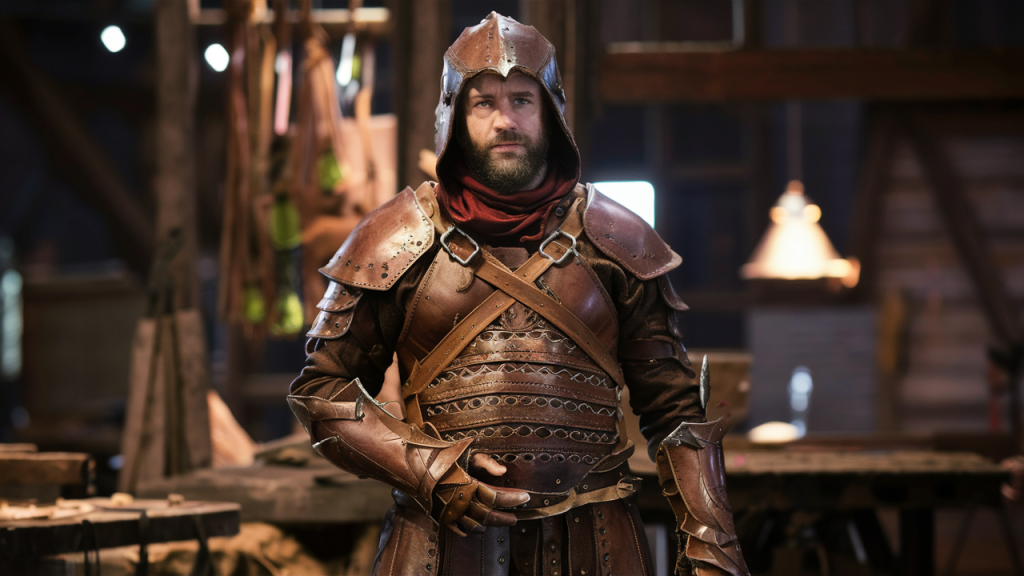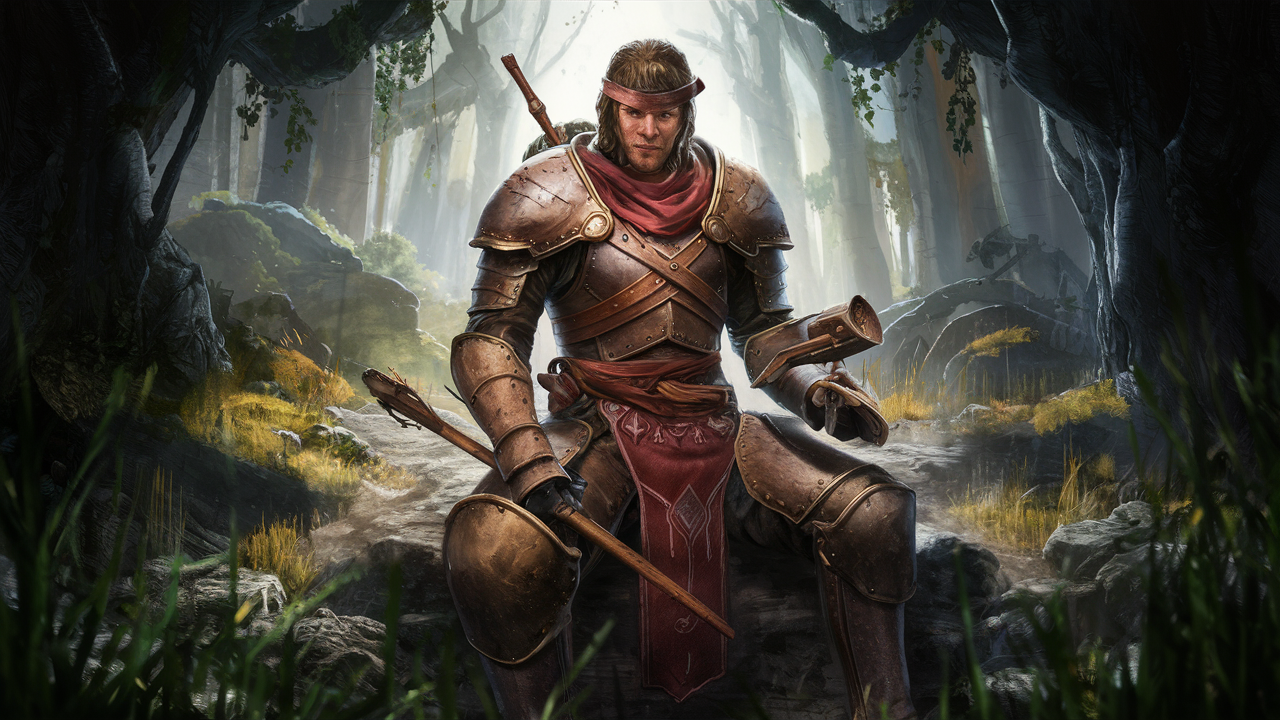Contrary to widespread belief, leather armor does not possess the softness or flexibility often found in the leather used for crafting a rogue’s boots or a ranger’s robe. Such materials, while comfortable and flexible, offer protection that is hardly superior to that of everyday attire.
In reality, leather armor embodies durability and rigidity, achieved through a meticulous process where the leather is treated in boiling oil and subsequently molded over wooden or stone forms replicating the torso shape of both men and women. This procedure results in robust breastplates and shoulder guards that are far from the delicate nature many assume them to be. These components are then typically worn over a tunic or kirtle, providing a sturdy yet somewhat flexible defense. In regions beset by colder weather, the ensemble might also include leggings crafted from wool or a softer type of leather, offering additional warmth without compromising mobility.
This comprehensive approach to crafting leather armor ensures that it serves as a reliable form of protection, capable of withstanding the rigors of battle while also accommodating the body’s need for movement. Far from the simplistic view of leather as merely a supple material for everyday clothing, leather armor stands as a testament to the ingenuity and skill of armorers, who have honed their craft to provide effective protection for warriors across various terrains and climates
Leather Armor In RPG Worlds
Leather armor stands as the quintessential gear in fantasy RPGs, primarily due to the widespread availability of its key components: leather and oil. These materials can be found in abundance across all realms of civilization, making the crafting of leather armor a straightforward task for any skilled leatherworker. The process involves boiling the leather in oil and then shaping it, a technique easily mastered by those familiar with leatherwork.
Affordable and resilient, leather armor typically consists of a stiff breastplate, ensuring that the wearer’s mobility remains largely unhampered. However, this design does leave the joints unprotected—a common vulnerability among various armor types, representing a longstanding challenge in armor development throughout history.
In the thick of battle, leather armor may require frequent replacements, possibly on a weekly basis. Yet, its maintenance is relatively simple; it withstands weather conditions well, remains largely unaffected by all but the most severe damage, and can be worn daily for extended periods without the need for immediate replacement. It’s not uncommon for both retired soldiers and middle-class militia members to keep a set of leather armor, attending to its upkeep with annual cleanings and polishings.
The raw materials for leather armor, derived from the routine consumption of meat, make it a staple in civilized societies. Even smaller, rural communities can quickly produce leather armor, utilizing hides from various animals such as cows, horses, sheep, and camels—each providing a suitable thickness for crafting durable armor.
Leather armor is particularly favored by irregular military units—militias, levies, freemen, and light infantry, among others. This preference is driven by several factors: its cost-effectiveness compared to metal armor, the comfort and health benefits of prolonged wear, the simplicity of its production allowing for rapid outfitting of troops with materials from recently conquered territories, and its longevity without the need for the meticulous care that metal armor demands.
A notable advantage of leather armor, especially valued by those engaged in stealth or subterfuge, is its capacity for quiet movement. Unlike metal armor, which can be betrayed by the clinking of buckles and fasteners, leather armor can be easily silenced with additional layers of clothing, aiding in concealment and stealth operations. Countless rogues have benefitted from the discreet nature of leather armor, evading detection during their clandestine activities.
Combining ease of movement, sufficient protection, stealth capabilities, widespread availability, and affordability, leather armor emerges as the preferred choice for a broad spectrum of individuals across human societies, embodying an ideal balance between functionality and accessibility.
When Is Leather Armor Mainly Used In RPG Campaigns?

Leather armor plays a pivotal role in role-playing game (RPG) campaigns, offering a versatile and practical option for many characters. Its usage spans a wide array of scenarios, tailored to the needs of specific character classes or campaign settings. Here are a few examples of when leather armor is commonly used in RPG campaigns:
- Stealth Missions and Reconnaissance: Characters such as spies, assassins, or scouts often rely on leather armor for missions requiring stealth and agility. Its lightweight nature allows for quiet movement, making it ideal for gathering intelligence or executing covert operations without alerting adversaries.
- Forest and Wilderness Settings: Rangers and druids, who spend a significant amount of time in the wilderness, may choose leather armor for its natural camouflage and flexibility, which are beneficial for navigating through dense forests or rugged terrain. Additionally, its compatibility with a nature-oriented lifestyle makes it a thematic choice for characters with strong ties to the natural world.
- Urban Adventures and Social Intrigue: In campaigns focused on urban environments and social intrigue, characters might opt for leather armor for its unobtrusive appearance, which can blend in more easily with civilian clothing. This can be particularly useful for characters like bards or rogues, who engage in diplomacy, espionage, or undercover missions within city walls.
- Light Combat Scenarios: Leather armor is a common choice for characters who expect to face combat situations but prioritize mobility over heavy protection. It offers a basic level of defense against low-level threats, making it suitable for adventurers in the early stages of a campaign or those facing enemies that rely more on speed than brute force.
- Artisans and Craftsmen Characters: In campaigns where characters have professions such as leatherworking or crafting, wearing leather armor can reflect their expertise and connection to their trade. These characters might even possess unique, self-crafted leather armor with special properties or enhancements, showcasing their skills.
- Cultural or Ritualistic Reasons: Some characters might wear leather armor as part of their cultural heritage or for ritualistic purposes. For instance, a member of a tribal society or a follower of a nature deity might wear leather armor as a symbol of their identity or devotion, integrating these elements into their role-playing and backstory.
- Traveling and Exploration: Adventurers who embark on long journeys or exploration missions in unknown territories may favor leather armor for its durability and ease of repair. Its comfort over long distances and the ability to withstand various environmental conditions without significant degradation make it a practical choice for explorers.
In each of these scenarios, the choice of leather armor is driven by a combination of practical considerations, character background, and the narrative needs of the RPG campaign. Its versatility and adaptability make it a staple in the adventurer’s arsenal, across a multitude of worlds and stories.
Which Player Classes Use Leather Armor In Fantasy RPGs?

In fantasy RPGs, leather armor is often utilized by player classes that balance the need for mobility, stealth, and a modicum of protection. Leather armor provides a good middle ground between the heavier armors that restrict movement and the lighter clothes that offer minimal defense. Here are some of the player classes typically associated with wearing leather armor:
- Rogues/Thieves: Rogues and thieves prioritize stealth and agility, making leather armor an ideal choice. Its quietness and flexibility allow them to move silently and avoid detection, crucial for sneaking, lockpicking, or ambushing.
- Rangers: Rangers, who often traverse wild and rugged terrains, wear leather armor for its durability and the protection it offers against environmental hazards. It also does not hinder their tracking, hunting, or archery skills.
- Druids: Druids have a deep connection with nature and usually prefer armor made from natural materials. Leather armor, especially when crafted from the hide of sacred or respected animals, is both symbolic and functional for them.
- Bards: Bards, known for their versatility and need for freedom of movement to perform, often wear leather armor. It provides enough protection without compromising their ability to entertain and cast spells.
- Assassins: Similar to rogues, assassins need to move quietly and quickly. Leather armor offers the perfect balance of protection and stealth for their deadly missions.
- Scouts: Scouts, who serve as the eyes and ears of their groups, rely on leather armor for its light weight and the ease with which it allows them to navigate through enemy territory undetected.
- Light Fighters or Duelists: Some fighters or duelists who focus on speed and maneuverability over brute strength may choose leather armor to maintain their agility in combat.
- Monks (in some RPG settings): While monks often rely on their martial prowess and avoid heavy armor, some settings allow monks to wear leather armor to provide a basic level of protection without hindering their mobility or martial arts skills.
- Certain types of Mages/Wizards: In some fantasy RPGs, specific subclasses of mages or wizards who blend magic with physical combat (like Spellswords or Battle Mages) might opt for leather armor to get a balance between protection and the freedom to cast spells.
Leather armor’s popularity among these classes stems from its versatility. It can be enchanted or reinforced for additional magical or physical defense, making it a staple choice for adventurers who value speed, subtlety, and adaptability.
Examples Of Characters That Use Leather Armor

Leather armor, as depicted in various fantasy settings and historical contexts, combines both practicality and aesthetic appeal, making it a popular choice for characters across numerous narratives. Here’s an exploration of characters from different sources that utilize leather armor:
- Aragorn (The Lord of the Rings): In Peter Jackson’s film adaptation of J.R.R. Tolkien’s epic, Aragorn, portrayed as a ranger and future king, often wears leather armor. This choice reflects his role as a versatile fighter who traverses Middle-earth’s diverse terrains, from the forests of Lothlórien to the plains of Gondor.
- Hunters and Shamans (World of Warcraft): In the expansive universe of World of Warcraft, both hunters and shamans frequently wear leather armor, especially at earlier levels before transitioning to mail armor. This armor type supports their roles requiring mobility and connection to the natural or elemental world.
- Characters in Dungeons & Dragons (D&D): Leather armor is a staple for many classes in D&D, particularly those that rely on stealth and dexterity, such as rogues and rangers. The game’s mechanics offer leather armor as a viable option for characters seeking a balance between protection and flexibility.
- NetHack Characters: In the roguelike game NetHack, leather armor appears as a basic form of protection for adventurers. Its inclusion underscores the game’s roots in fantasy tropes and its homage to traditional RPG elements.
- Historical Warriors: While not specific characters, historical warriors across various cultures have utilized leather armor for its availability and ease of crafting. This real-world application has undoubtedly inspired its frequent use in fantasy settings, providing a grounded basis for its inclusion.
- Crafters in Fantasy Worlds: The EN World forum discussion about who makes leather armor in fantasy worlds highlights the often overlooked characters – the craftsmen. These NPCs, ranging from tanners to armorsmiths, play a crucial role in outfitting heroes for their adventures, adding depth to the world-building.
- Warriors in Game of Thrones Inspired Settings: Drawing inspiration from Game of Thrones, characters in 5E D&D and other fantasy RPG settings might opt for studded leather armor. This choice reflects a warrior’s need for protection that doesn’t sacrifice stealth and agility, suitable for the political and physical battles of such a harsh and treacherous world.
These examples illustrate the broad application and appeal of leather armor across different media and narratives. Whether through the lens of high fantasy, historical reimagining, or the mechanics of RPGs, leather armor remains a compelling choice for characters navigating the challenges and adventures of their respective worlds.
Characters That Use Leather Armor

In the realm of fantasy RPGs, leather armor is a popular choice for a wide range of characters, offering a balance between protection, stealth, and flexibility. Here are some fictional examples inspired by the typical use of leather armor within these settings:
- Aerith Swiftwind – Profession: Rogue
- Personality Traits: Quick-witted, resourceful, with a penchant for finding trouble and getting out of it just as quickly. Aerith’s agility and stealth are enhanced by her leather armor, which she acquired from a master thief during her initiation into the Thieves’ Guild.
- Caelum Nightshade – Profession: Ranger
- Personality Traits: Stoic, with a deep respect for nature and an unparalleled ability to track and hunt. Caelum wears leather armor crafted from the hides of creatures he has respectfully hunted, believing in honoring their spirits by using every part of them.
- Luna Moonbender – Profession: Druid
- Personality Traits: Compassionate and mystical, Luna has a profound connection to the natural world. Her leather armor is adorned with symbols of her faith and was given to her during a sacred ceremony in her grove, signifying her bond with nature.
- Darius Shadowstep – Profession: Assassin
- Personality Traits: Calculating and silent, Darius is a master of moving unseen and striking without warning. His dark leather armor, a trophy from his first successful mission, serves as both protection and a symbol of his deadly skills.
- Briar Roseheart – Profession: Bard
- Personality Traits: Charismatic and adventurous, Briar thrives in the spotlight and on the open road. Her ornate leather armor doubles as performance attire, each piece telling a story of her travels and the tales she weaves.
- Garrick Ironfist – Profession: Monk
- Personality Traits: Disciplined and serene, yet formidable when provoked. Garrick’s simple leather armor reflects his monastic vows of poverty and humility, while providing him the mobility needed to execute his martial arts techniques.
- Elara Dawnwhisper – Profession: Sorcerer
- Personality Traits: Enigmatic and fiercely intelligent, Elara harnesses arcane powers that often surprise her foes. Her leather armor is infused with magical runes to enhance her protection without hindering her spellcasting abilities.
- Thorne Blackwater – Profession: Pirate Captain
- Personality Traits: Daring, charismatic, and a bit roguish, Thorne commands loyalty from his crew and fear from his enemies. His leather armor is both functional and imposing, decorated with trophies from his conquests at sea.

These characters showcase the versatility of leather armor across various professions and roles within fantasy RPGs. Whether enhancing a character’s connection to nature, aiding in their stealthy endeavors, or serving as a badge of honor, leather armor plays a crucial role in defining these adventurers and their journeys.
Read more about armor in the fantasy RPG world
